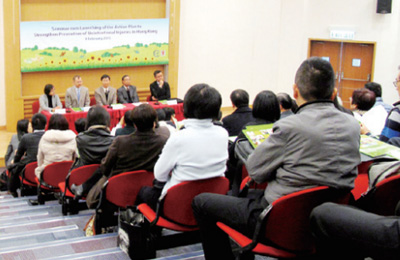 Leisure and Cultural Services Department - Community Sports Club BulletinLeisure and Cultural Services Department
Leisure and Cultural Services Department - Community Sports Club BulletinLeisure and Cultural Services Department
Sports Kaleidoscope
Facing Up To Unintentional Injury
 |
In order to promote a healthy lifestyle and raise public safety awareness, the Department of Health launched the “Seminar cum Launching of the Action Plan to Strengthen Prevention of Unintentional Injuries in Hong Kong”. A number of local and overseas experts were arranged to host lectures and public forums in the expectation of improving public awareness of unintentional injury and resulting non-communicable diseases (NCSs).
Under Secretary for Food & Health, Prof Sophia CHAN, and Chairman of the Working Group on Injuries, Mr Patrick MA, kicked off the Seminar cum Launching ceremony and made the welcoming speeches. At the ceremony, Prof CHAN spoke about how having a healthy lifestyle, avoiding high-risk behaviours and making healthier choices in our daily lives could help to prevent NCSs. Mr MA also mentioned that the Action Plan had been adjusted appropriately based on the local situation after making careful consideration, drawing reference to valid evidence, and communicating with stakeholders from various sectors.
The first seminar of the day with the theme of “An International Perspective and Experience on Prevention of Unintentional Injury” was presented by Jonathon PASSMORE, the representative from the World Health Organization Regional Office for the Western Pacific Region. He said that many injury prevention methods used in high-income areas could also be applied to low-income areas, so reference could be drawn from the experiences of high-income areas such as Hong Kong. He added that most low-income areas lacked a complete prevention and control system, but now that Hong Kong has adopted injury prevention as a prioritised area of work, and thus increased its efforts in this area, his visit to Hong Kong was very beneficial to him. He also encouraged everyone present to refer to the World Health Organization’s website for injury prevention recommendations and actively provide feedback.
Dr Regina CHING, Secretary of the Working Group on Injuries then announced the Action Plan to Strengthen Prevention of Unintentional Injuries in Hong Kong. The Working Group on Injuries was formally established on 6 February 2012 and has met four times to provide injury prevention advice and formally develop goals and action plans. In recent years, the number of deaths resulting from injuries has become a matter of concern, e.g. in 2013, injury was the fifth leading cause of death in Hong Kong. In light of this, the Working Group on Injuries developed five strategic directions: (1) Support new and strengthen existing health promotion activities on injury prevention; (2) Generate a comprehensive and effective information system to understand the epidemiology of injuries and to provide advice and support on prevention of injuries; (3) Strengthen partnership and foster engagement of all relevant stakeholders; (4) Build capacity and capability to prevent injuries; and (5) Ensure a health sector that is responsive to the NCD challenges and to improve the healthcare system. The Working group listed 16 proposals for action: e.g. to improve the injury surveillance system, explore casualty cases to improve understanding of injury patterns, and encourage research on injury-related areas, etc. The aim of the Action Plan was to change the public’s negative attitude towards injury prevention, convey positive messages on safety promotion and performance enhancement, and reduce the chance of injury in specific environment and groups.
The next two parts of the seminar illustrated two important categories of injury: sports injuries and children’s injuries, and the talks were presented by two members of the Working Group, Dr Patrick YUNG and Dr CHOW Chun-bong, respectively. In “Prevention of sports injuries and drowning”, Dr YUNG pointed out that sports injuries and drowning were highlighted as two of the four priority areas of injury prevention. According to statistics, sports injuries were more common among the male gender. Inappropriate training methods and excessive exercise, etc. were some of the reasons for sports injuries, whereas falls and sprains were categories of sports injuries. With regards to drowning casualties, according to statistics, although fewer deaths were caused by drowning when compared with the other major reasons for injuries, the mortality rate was particularly high in drowning incidents. In other words, drowning was more lethal than other types of injury. With regards to gender, over the past decade, males were involved in more drowning cases than females, comprising of about 60% to 80% of death cases annually. Drowning mostly occurred in natural water, such as the sea, rivers and streams. Most drowning incidents took place during the weekend and in the afternoon, and respiratory or nervous system problems were common causes of drowning. To improve the situation, the Working Group recommended strengthening monitoring and prevention in schools and communities and teaching teachers and coaches about sport injury prevention. On the other hand, in “Household injuries and falls of Hong Kong children”, Dr CHOW cited data showing that household fall injuries were most prevalent among children and the elderly, and pointed out that most incidents of falls took place in the Kwai Tsing and Sham Shui Po District, the least incidents of falls took place in Wan Chai District, and that the streets and sports venues were also high-risk areas. He suggested that injury cases should be studied according to age and district to prioritise the handling of high-risk persons’ needs.
At the end, Dr Charles CHAN of the Working Group hosted the open forum to close the seminar cum launching ceremony. It was hoped that by introducing the public to this issue, the public would gain a deeper awareness of and re-examine the importance of injury prevention, so as to choose a healthier and safer lifestyle for themselves and the people around them. Please visit change4health.gov.hk for more information on injury prevention.
 |
